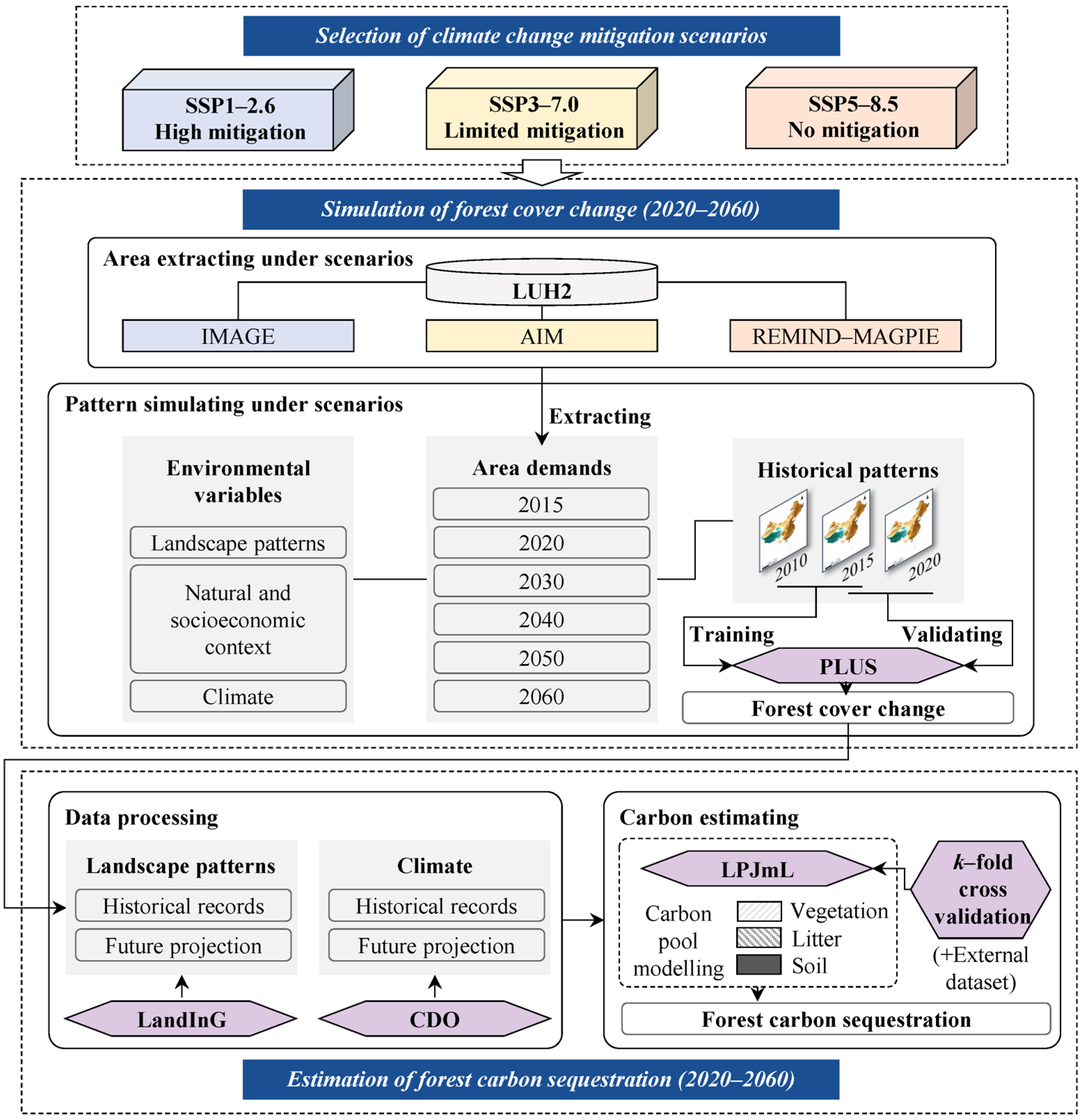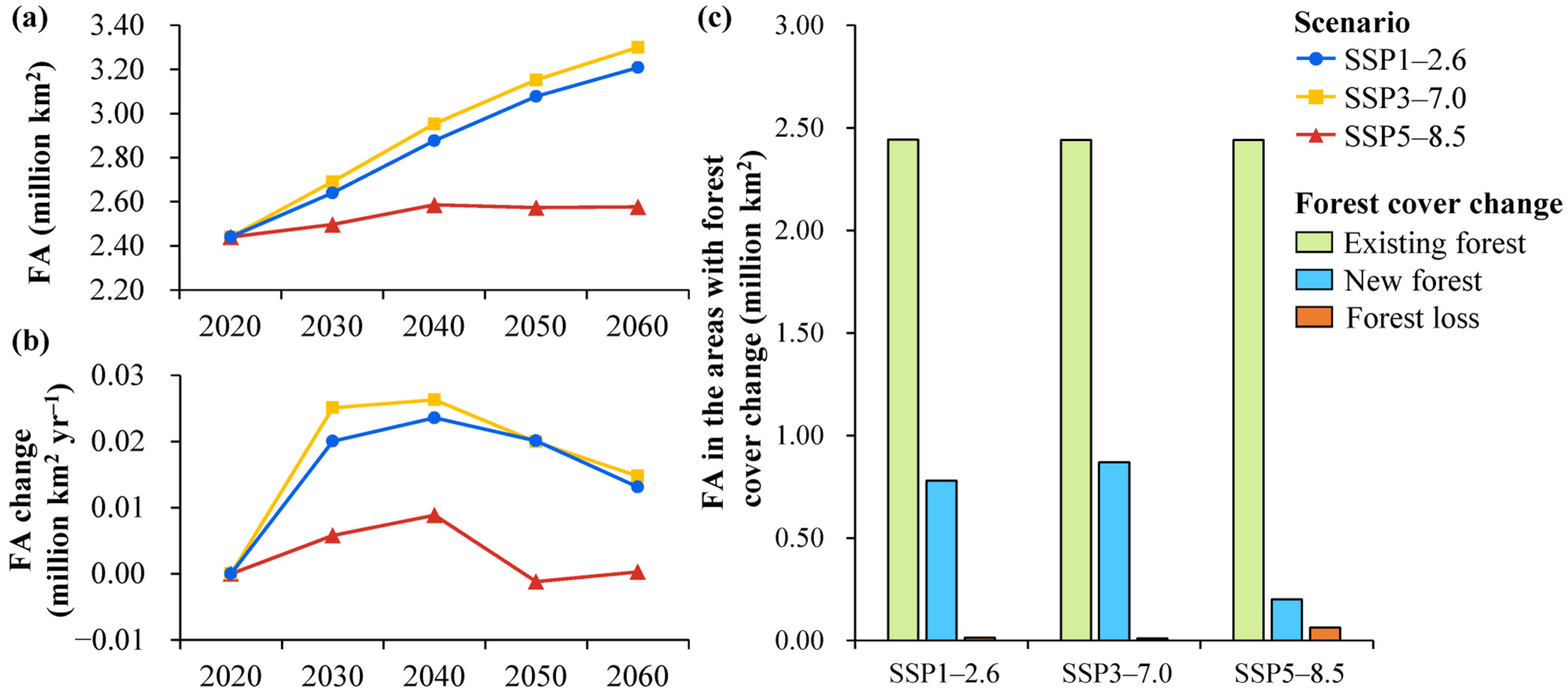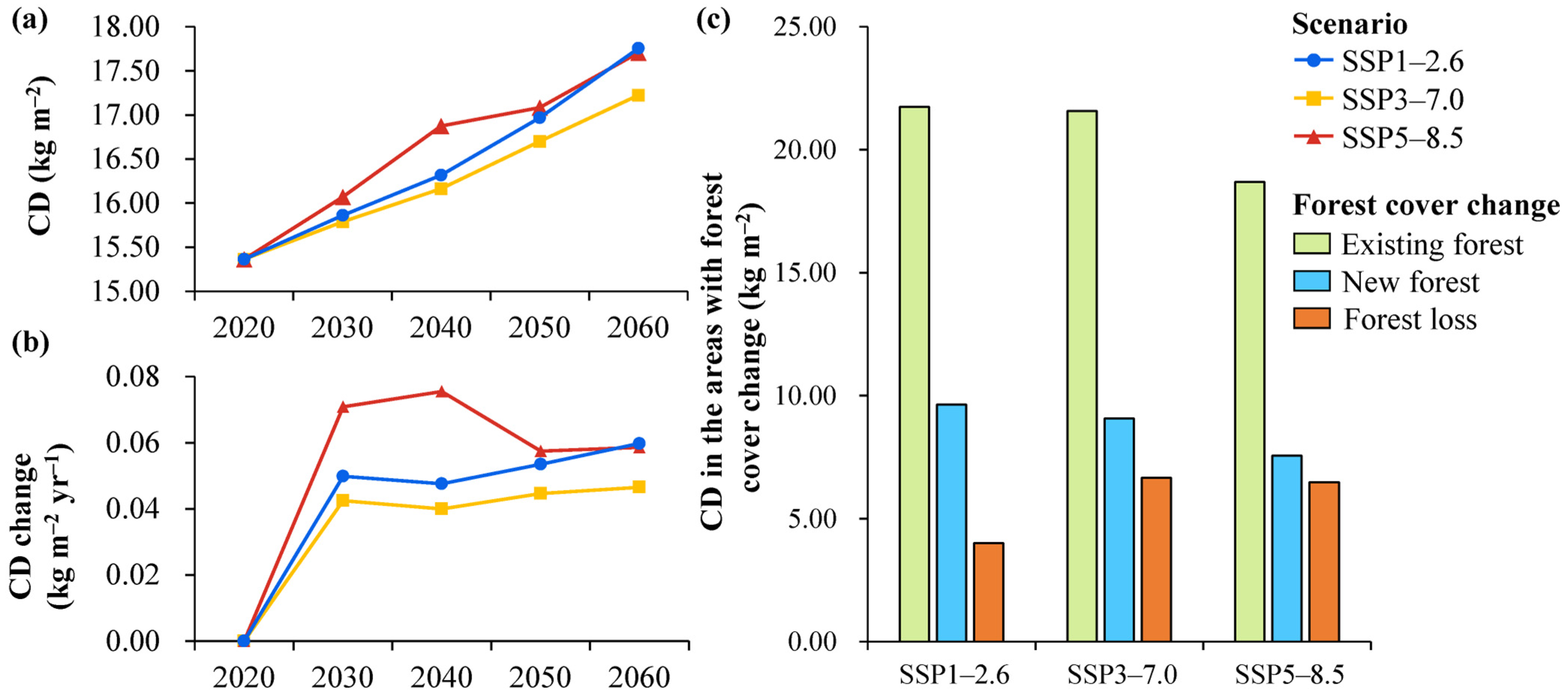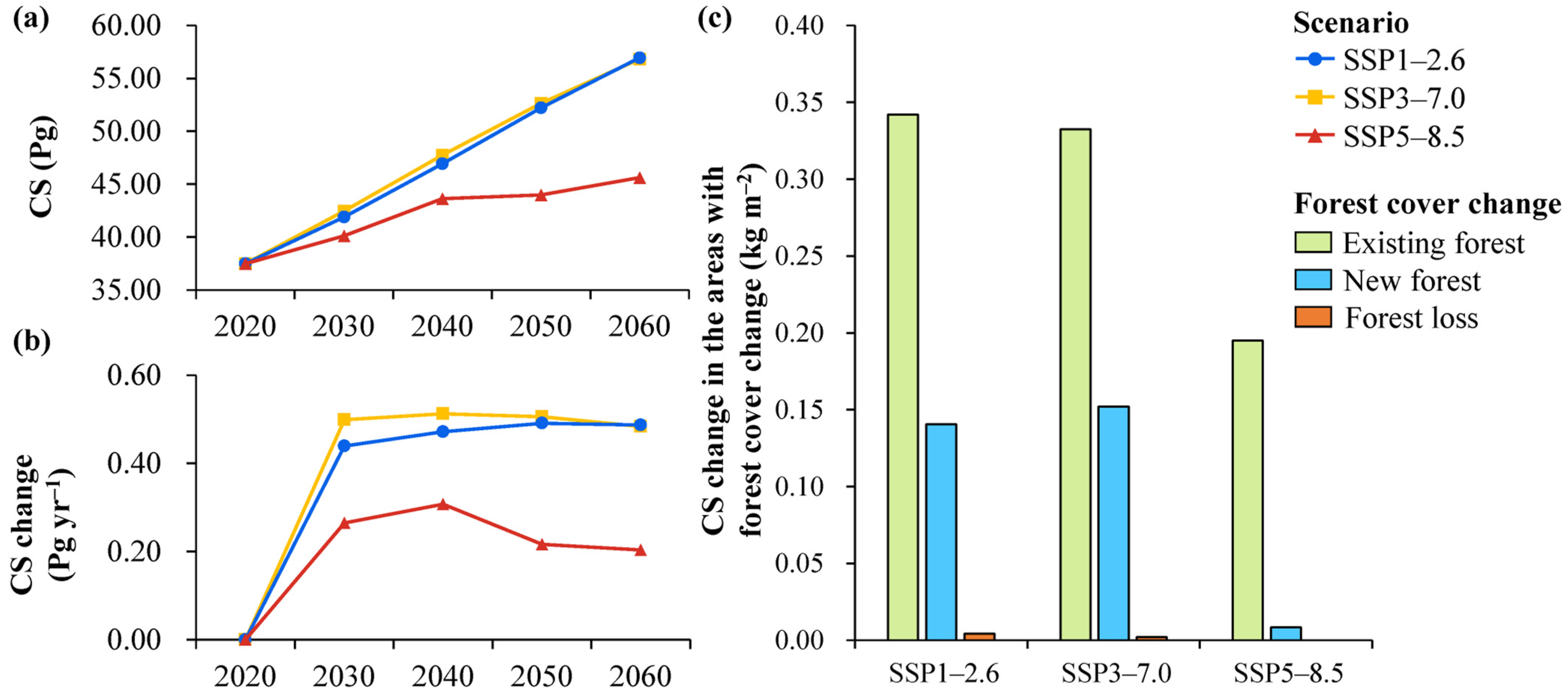Assessing Forest Carbon Sequestration in China Under Multiple Climate Change Mitigation Scenarios
Abstract
1. Introduction
2. Materials and Methods
2.1. Methodology
2.1.1. Description of Climate Change Mitigation Policy Scenarios
2.1.2. Simulation of Forest Cover Change
2.1.3. Estimation of Forest Carbon Sequestration
2.1.4. Model Implementation and Validation
2.2. Data Sources
3. Results
3.1. Forest Area Change Across Scenarios
3.2. Forest Carbon Density Across Scenarios
3.3. Forest Carbon Sequestration Across Scenarios
4. Discussion
4.1. Changes in China’s Forest Carbon Sequestration Under Climate Mitigation Policies
4.2. Uncertainties and Limitations
5. Conclusions
Author Contributions
Funding
Data Availability Statement
Conflicts of Interest
Appendix A
| Scenarios | SSP1-2.6 | SSP3-7.0 | SSP5-8.5 |
|---|---|---|---|
| (a) RCPs | RCP2.6 | RCP7.0 | RCP8.5 |
| Pathway | Peak and decline | Stabilize without overshoot | Rise |
| Climate policies | Highest mitigation | Limited mitigation | No mitigation |
| Temperature rise | ~2 °C by 2100 | ~4 °C by 2100 | ~5 °C by 2100 |
| Radiative forcing | ~2.6 W m−2 in 2100 | ~7.0 W m−2 in 2100 | ~8.5 W m−2 in 2100 |
| CO2 concentration | ~490 ppm in 2100 | ~850 ppm in 2100 | ~1370 ppm in 2100 |
| (b) SSPs | SSP1 | SSP3 | SSP5 |
| Pathway | Sustainability | Regional rivalry | Fossil-fueled |
| Fossil fuels reliance | Decline | Heavy | Heavy |
| Energy intensity | Low | Intermediate | High |
| Globalization | Moderate | Constrained | High |
| Technology development | Rapid | Slow | Rapid |
| Population growth | Relatively slow | Relatively rapid | Relatively slow |
| Economic growth | Medium to high | Slow | High |
| Agricultural production | Improved with practice diffusion | Low with restricted trade and technology | Highly managed and resource-intensive |
| (c) LUH2 | IMAGE | AIM | REMIND-MAGPIE |
| Land-use regulation | Strong to avoid environmental trade-offs | Limited with continued deforestation | Medium with slowing deforestation |
| Land-use pressure | Moderate | High | Medium |
| Component | Type | Variable | Potential Impact |
|---|---|---|---|
| Macroclimatic conditions | Climate | Mean temperature | Optimal temperature enhances vegetation activity. Cold conditions at high elevations promote growth through land abandonment, while extreme cold hinder forest succession due to soil saturation and physiological constraints [15,53]. |
| Annual precipitation | High annual precipitation shows similar impacts of cold temperatures [54]. | ||
| Precipitation of driest quarter | Low precipitation during the driest four months raises wildfire risks and limits water availability, leading to stomatal closure and limited CO2 uptake [53,55]. | ||
| Precipitation seasonality | High variation in monthly precipitation enhances biomass accumulation [54], but extreme fluctuations increase seasonal droughts and wildfire risks [19]. | ||
| Regional environments | Soil | Soil pH | Soil pH impacts plant adaptation, microbial activity, and nutrient availability [56]. |
| Sand texture | High sand content indicates nutrient-poor soils that accelerate nutrient leaching and limit biomass accumulation [56]. | ||
| Cation Exchange Capacity (CEC) | High CEC indicates fertile soils with a high capacity to hold potassium, calcium, magnesium, and other positively charged elements, supporting primary productivity recovery of forests [54]. | ||
| Bulk density | High bulk density indicates soil compaction, which restricts root growth, gas exchange, and seed germination [56]. | ||
| Topography | Elevation | High elevation accelerates forest growth by promoting land abandonment and limiting economically viable land [17,56]. | |
| Slope | Steeper slopes facilitate growth but are susceptible to erosion [17,56]. | ||
| Aspect | Southeast-facing slopes in China enhance moisture availability and promote restoration [17]. | ||
| Population | Rural population density | High rural population density drives deforestation through land clearing for agriculture, while urbanization-induced population decline may foster agricultural abandonment and promote recovery [57]. | |
| Urban population density | The effects of urban population density are mixed; urban expansion may encroach on forests, but rural abandonment can enhance recovery potential [57]. | ||
| Foreign population density | High foreign population density may improve environmental awareness and forest protection efforts [56]. | ||
| Economy | Fixed-asset investment | High fixed-asset investment hinders forest growth by increasing land prices and opportunity costs for forest restoration [58]. | |
| GDP | GDP reveals an inverted U-shaped relationship with forest recovery, correlating with initial deforestation [55]. | ||
| Forestry output value | High forestry output typically leads to greater deforestation [17,45]. | ||
| Agricultural output value | High agricultural output limits forest growth due to intensive disturbance and high costs for forest restoration [17,56]. | ||
| Pastoral output value | High pastoral output shows similar impacts as agriculture [17,56]. | ||
| Industrial output value | High industrial output may create non-agricultural jobs that support forest growth but can also result in deforestation as forestry rises [55]. | ||
| Landscape patterns | Land use | Cropland proportion | High cropland proportion in the 1 km buffer (hereafter, proportion) can either provide space for forest growth or increase deforestation risk [15,56]. |
| Grassland proportion | High grassland proportion presents uncertain effects as that of cropland [56]. | ||
| Proximity to water | Closer proximity promotes forest growth due to water availability and riparian vegetation protection. But navigable rivers can attract habitation, increasing deforestation risks [56]. | ||
| Proximity to impervious | Closer proximity to impervious hinders recovery due to human encroachment [59]. | ||
| Forest state | Forest proportion | High proportion of forest cover supports forest growth by providing seed sources and facilitating species dispersal [17]. | |
| Loss proportion | High proportion of forest loss indicates significant pressures on forests [19]. |
| CLCD Class | LUH2 State |
|---|---|
| Impervious | Urban land (urban) |
| Forest | Forested primary land (primf), potentially forested secondary land (secdf) |
| Cropland | C3 annual crops (c3ann), C4 annual crops (c4ann), C3 perennial crops (c3per), C4 perennial crops (c4per), C3 nitrogen-fixing crops (c3nfx) |
| Shrub, grassland | Non-forested primary land (primn), potentially non-forested secondary land (secdn), managed pasture (pastr), rangeland (range) |
| Water, Show/Ice, Wetland, Barren | Areas excluding primf, primn, secdf, secdn, pastr, range, c3ann, c4ann, c3per, c4per, c3nfx |



References
- Griscom, B.W.; Adams, J.; Ellis, P.W.; Houghton, R.A.; Lomax, G.; Miteva, D.A.; Schlesinger, W.H.; Shoch, D.; Siikamäki, J.V.; Smith, P.; et al. Natural climate solutions. Proc. Natl. Acad. Sci. USA 2017, 114, 11645–11650. [Google Scholar] [CrossRef] [PubMed]
- Anderegg, W.R.L.; Trugman, A.T.; Badgley, G.; Anderson, C.M.; Bartuska, A.; Ciais, P.; Cullenward, D.; Field, C.B.; Freeman, J.; Goetz, S.J.; et al. Climate-driven risks to the climate mitigation potential of forests. Science 2020, 368, eaaz7005. [Google Scholar] [CrossRef]
- Xu, H.; Yue, C.; Zhang, Y.; Liu, D.; Piao, S.L. Forestation at the right time with the right species can generate persistent carbon benefits in China. Proc. Natl. Acad. Sci. USA 2023, 120, e2304988120. [Google Scholar] [CrossRef]
- Bonan, G.B. Forests and climate change: Forcings, feedbacks, and the climate benefits of forests. Science 2008, 320, 1444–1449. [Google Scholar] [CrossRef]
- He, J.K.; Li, Z.; Zhang, X.L.; Wang, H.L.; Dong, W.J.; Chang, S.Y.; Ou, X.M.; Guo, S.Y.; Tian, Z.Y.; Gu, A.L.; et al. Comprehensive report on China’s Long-Term Low-Carbon Development Strategies and Pathways. Chin. J. Popul. Resour. Environ. 2020, 18, 263–295. [Google Scholar] [CrossRef]
- Qi, J.J.; Dauvergne, P. China and the global politics of nature-based solutions. Environ. Sci. Policy 2022, 137, 1–11. [Google Scholar] [CrossRef]
- Koch, A.; Kaplan, J.O. Tropical forest restoration under future climate change. Nat. Clim. Change 2022, 12, 279–283. [Google Scholar] [CrossRef]
- Seidl, R.; Thom, D.; Kautz, M.; Martin-Benito, D.; Peltoniemi, M.; Vacchiano, G.; Wild, J.; Ascoli, D.; Petr, M.; Honkaniemi, J.; et al. Forest disturbances under climate change. Nat. Clim. Change 2017, 7, 395–402. [Google Scholar] [CrossRef]
- Gai, Z.; Zheng, W.; Faye, B.; Wang, H.; Du, G. Temporal and Spatial Characteristics and Influencing Factors of Carbon Storage in Black Soil Area Under Topographic Gradient. Land 2025, 14, 16. [Google Scholar] [CrossRef]
- Nie, Q.; Man, W.; Li, Z.; Wu, X. From Policy to Practice: Assessing Carbon Storage in Fujian Province Using Patch-Generating Land Use Simulation and Integrated Valuation of Ecosystem Services and Tradeoffs Models. Land 2025, 14, 179. [Google Scholar] [CrossRef]
- Anderson, R.P.; Lew, D.; Peterson, A.T. Evaluating predictive models of species’ distributions: Criteria for selecting optimal models. Ecol. Modell. 2003, 162, 211–232. [Google Scholar] [CrossRef]
- Elith, J.; Leathwick, J.R. Species Distribution Models: Ecological Explanation and Prediction Across Space and Time. Annu. Rev. Ecol. Evol. Syst. 2009, 40, 677–697. [Google Scholar] [CrossRef]
- Bastin, J.F.; Finegold, Y.; Garcia, C.; Mollicone, D.; Rezende, M.; Routh, D.; Zohner, C.M.; Crowther, T.W. The global tree restoration potential. Science 2019, 365, 76–79. [Google Scholar] [CrossRef] [PubMed]
- Gauthier, S.; Bernier, P.; Kuuluvainen, T.; Shvidenko, A.Z.; Schepaschenko, D.G. Boreal forest health and global change. Science 2015, 349, 819–822. [Google Scholar] [CrossRef]
- Molin, P.G.; Chazdon, R.; Ferraz, S.F.D.; Brancalion, P.H.S. A landscape approach for cost-effective large-scale forest restoration. J. Appl. Ecol. 2018, 55, 2767–2778. [Google Scholar] [CrossRef]
- Strassburg, B.B.N.; Beyer, H.L.; Crouzeilles, R.; Iribarrem, A.; Barros, F.; de Siqueira, M.F.; Sánchez-Tapia, A.; Balmford, A.; Sansevero, J.B.B.; Brancalion, P.H.S.; et al. Strategic approaches to restoring ecosystems can triple conservation gains and halve costs. Nat. Ecol. Evol. 2019, 3, 62–70. [Google Scholar] [CrossRef] [PubMed]
- Crk, T.; Uriarte, M.; Corsi, F.; Flynn, D. Forest recovery in a tropical landscape: What is the relative importance of biophysical, socioeconomic, and landscape variables? Landscape Ecol. 2009, 24, 629–642. [Google Scholar] [CrossRef]
- Villa, P.M.; Martins, S.V.; Neto, S.N.D.; Rodrigues, A.C.; Martorano, L.G.; Monsanto, L.D.; Cancio, N.M.; Gastauer, M. Intensification of shifting cultivation reduces forest resilience in the northern Amazon. For. Ecol. Manag. 2018, 430, 312–320. [Google Scholar] [CrossRef]
- Curtis, P.G.; Slay, C.M.; Harris, N.L.; Tyukavina, A.; Hansen, M.C. Classifying drivers of global forest loss. Science 2018, 361, 1108–1111. [Google Scholar] [CrossRef]
- Schipper, A.M.; Hilbers, J.P.; Meijer, J.R.; Antão, L.H.; Benítez-López, A.; de Jonge, M.M.; Leemans, L.H.; Scheper, E.; Alkemade, R.; Doelman, J.C. Projecting terrestrial biodiversity intactness with GLOBIO 4. Glob. Change Biol. 2020, 26, 760–771. [Google Scholar] [CrossRef]
- Cutler, D.R.; Edwards, T.C.; Beard, K.H.; Cutler, A.; Hess, K.T. Random forests for classification in ecology. Ecology 2007, 88, 2783–2792. [Google Scholar] [CrossRef] [PubMed]
- Lu, N.; Tian, H.Q.; Fu, B.J.; Yu, H.Q.; Piao, S.L.; Chen, S.Y.; Li, Y.; Li, X.Y.; Wang, M.Y.; Li, Z.D.; et al. Biophysical and economic constraints on China’s natural climate solutions. Nat. Clim. Change 2022, 12, 847–853. [Google Scholar] [CrossRef]
- Chen, G.Z.; Li, X.; Liu, X.P.; Chen, Y.M.; Liang, X.; Leng, J.Y.; Xu, X.C.; Liao, W.L.; Qiu, Y.A.; Wu, Q.L.; et al. Global projections of future urban land expansion under shared socioeconomic pathways. Nat. Commun. 2020, 11, 537. [Google Scholar] [CrossRef]
- Liang, X.; Guan, Q.F.; Clarke, K.C.; Liu, S.S.; Wang, B.Y.; Yao, Y. Understanding the drivers of sustainable land expansion using a patch-generating land use simulation (PLUS) model: A case study in Wuhan, China. Comput. Environ. Urban Syst. 2021, 85, 101569. [Google Scholar] [CrossRef]
- Hurtt, G.C.; Chini, L.; Sahajpal, R.; Frolking, S.; Bodirsky, B.L.; Calvin, K.; Doelman, J.C.; Fisk, J.; Fujimori, S.; Goldewijk, K.K.; et al. Harmonization of global land use change and management for the period 850-2100 (LUH2) for CMIP6. Geosci. Model Dev. 2020, 13, 5425–5464. [Google Scholar] [CrossRef]
- Kim, H.; Rosa, I.M.D.; Alkemade, R.; Leadley, P.; Hurtt, G.; Popp, A.; van Vuuren, D.P.; Anthoni, P.; Arneth, A.; Baisero, D.; et al. A protocol for an intercomparison of biodiversity and ecosystem services models using harmonized land-use and climate scenarios. Geosci. Model Dev. 2018, 11, 4537–4562. [Google Scholar] [CrossRef]
- Cai, W.X.; He, N.P.; Li, M.X.; Xu, L.; Wang, L.Z.; Zhu, J.H.; Zeng, N.; Yan, P.; Si, G.X.; Zhang, X.Q.; et al. Carbon sequestration of Chinese forests from 2010 to 2060: Spatiotemporal dynamics and its regulatory strategies. Sci. Bull. 2022, 67, 836–843. [Google Scholar] [CrossRef] [PubMed]
- Ouyang, Z.; Zheng, H.; Xiao, Y.; Polasky, S.; Liu, J.; Xu, W.; Wang, Q.; Zhang, L.; Xiao, Y.; Rao, E.M.; et al. Improvements in ecosystem services from investments in natural capital. Science 2016, 352, 1455–1459. [Google Scholar] [CrossRef]
- Zhang, Y.; Cheng, C.; Wang, Z.; Hai, H.; Miao, L. Spatiotemporal Variation and Driving Factors of Carbon Sequestration Rate in Terrestrial Ecosystems of Ningxia, China. Land 2025, 14, 94. [Google Scholar] [CrossRef]
- Ostberg, S.; Mueller, C.; Heinke, J.; Schaphoff, S. LandInG 1.0: A toolbox to derive input datasets for terrestrial ecosystem modelling at variable resolutions from heterogeneous sources. Geosci. Model Dev. 2023, 16, 3375–3406. [Google Scholar] [CrossRef]
- Schaphoff, S.; von Bloh, W.; Rammig, A.; Thonicke, K.; Biemans, H.; Forkel, M.; Gerten, D.; Heinke, J.; Jägermeyr, J.; Knauer, J.; et al. LPJmL4-a dynamic global vegetation model with managed land—Part 1: Model description. Geosci. Model Dev. 2018, 11, 1343–1375. [Google Scholar] [CrossRef]
- Lawrence, D.M.; Hurtt, G.C.; Arneth, A.; Brovkin, V.; Calvin, K.V.; Jones, A.D.; Jones, C.D.; Lawrence, P.J.; de Noblet-Ducoudré, N.; Pongratz, J.; et al. The Land Use Model Intercomparison Project (LUMIP) contribution to CMIP6: Rationale and experimental design. Geosci. Model Dev. 2016, 9, 2973–2998. [Google Scholar] [CrossRef]
- Tebaldi, C.; Debeire, K.; Eyring, V.; Fischer, E.; Fyfe, J.; Friedlingstein, P.; Knutti, R.; Lowe, J.; O’Neill, B.; Sanderson, B.; et al. Climate model projections from the Scenario Model Intercomparison Project (ScenarioMIP) of CMIP6. Earth Syst. Dyn. 2021, 12, 253–293. [Google Scholar] [CrossRef]
- Moss, R.H.; Edmonds, J.A.; Hibbard, K.A.; Manning, M.R.; Rose, S.K.; van Vuuren, D.P.; Carter, T.R.; Emori, S.; Kainuma, M.; Kram, T.; et al. The next generation of scenarios for climate change research and assessment. Nature 2010, 463, 747–756. [Google Scholar] [CrossRef] [PubMed]
- Popp, A.; Calvin, K.; Fujimori, S.; Havlik, P.; Humpenöder, F.; Stehfest, E.; Bodirsky, B.L.; Dietrich, J.P.; Doelmann, J.C.; Gusti, M.; et al. Land-use futures in the shared socio-economic pathways. Glob. Environ. Change-Human Policy Dimens. 2017, 42, 331–345. [Google Scholar] [CrossRef]
- Shiogama, H.; Fujimori, S.; Hasegawa, T.; Hayashi, M.; Hirabayashi, Y.; Ogura, T.; Iizumi, T.; Takahashi, K.; Takemura, T. Important distinctiveness of SSP3-7.0 for use in impact assessments. Nat. Clim. Change 2023, 13, 1276–1278. [Google Scholar] [CrossRef]
- Friedlingstein, P.; Meinshausen, M.; Arora, V.K.; Jones, C.D.; Anav, A.; Liddicoat, S.K.; Knutti, R. Uncertainties in CMIP5 Climate Projections due to Carbon Cycle Feedbacks. J. Clim. 2014, 27, 511–526. [Google Scholar] [CrossRef]
- Liao, W.L.; Liu, X.P.; Xu, X.Y.; Chen, G.Z.; Liang, X.; Zhang, H.H.; Li, X. Projections of land use changes under the plant functional type classification in different SSP-RCP scenarios in China. Sci. Bull. 2020, 65, 1935–1947. [Google Scholar] [CrossRef]
- Morin, X.; Fahse, L.; Jactel, H.; Scherer-Lorenzen, M.; García-Valdés, R.; Bugmann, H. Long-term response of forest productivity to climate change is mostly driven by change in tree species composition. Sci. Rep. 2018, 8, 5627. [Google Scholar] [CrossRef]
- Sitch, S.; Smith, B.; Prentice, I.C.; Arneth, A.; Bondeau, A.; Cramer, W.; Kaplan, J.O.; Levis, S.; Lucht, W.; Sykes, M.T.; et al. Evaluation of ecosystem dynamics, plant geography and terrestrial carbon cycling in the LPJ dynamic global vegetation model. Glob. Change Biol. 2003, 9, 161–185. [Google Scholar] [CrossRef]
- Yang, J.; Huang, X. The 30 m annual land cover dataset and its dynamics in China from 1990 to 2019. Earth Syst. Sci. Data 2021, 13, 3907–3925. [Google Scholar] [CrossRef]
- Yang, Q.L.; Niu, C.Y.; Liu, X.Q.; Feng, Y.H.; Ma, Q.; Wang, X.J.; Tang, H.; Guo, Q.H. Mapping high-resolution forest aboveground biomass of China using multisource remote sensing data. GISci. Remote Sens. 2023, 60, 2203303. [Google Scholar] [CrossRef]
- Fang, J.; Yu, G.; Liu, L.; Hu, S.; Chapin, F.S. Climate change, human impacts, and carbon sequestration in China. Proc. Natl. Acad. Sci. USA 2018, 115, 4015–4020. [Google Scholar] [CrossRef] [PubMed]
- Chen, J.D.; Gao, M.; Cheng, S.L.; Hou, W.X.; Song, M.L.; Liu, X.; Liu, Y. Global 1 km x 1 km gridded revised real gross domestic product and electricity consumption during 1992-2019 based on calibrated nighttime light data. Sci. Data 2022, 9, 202. [Google Scholar] [CrossRef]
- Hansen, M.C.; Potapov, P.V.; Moore, R.; Hancher, M.; Turubanova, S.A.; Tyukavina, A.; Thau, D.; Stehman, S.V.; Goetz, S.J.; Loveland, T.R.; et al. High-resolution global maps of 21st-century forest cover change. Science 2013, 342, 850–853. [Google Scholar] [CrossRef]
- Canadell, J.G.; Le Quéré, C.; Raupach, M.R.; Field, C.B.; Buitenhuis, E.T.; Ciais, P.; Conway, T.J.; Gillett, N.P.; Houghton, R.A.; Marland, G. Contributions to accelerating atmospheric CO2 growth from economic activity, carbon intensity, and efficiency of natural sinks. Proc. Natl. Acad. Sci. USA 2007, 104, 18866–18870. [Google Scholar] [CrossRef]
- Zheng, H.; Ouyang, Z.Y.; Xu, W.H.; Wang, X.K.; Miao, H.; Li, X.Q.; Tian, Y.X. Variation of carbon storage by different reforestation types in the hilly red soil region of southern China. For. Ecol. Manag. 2008, 255, 1113–1121. [Google Scholar] [CrossRef]
- Liu, D.F.; Li, F.X.; Qiu, M.L.; Zhang, Y.; Zhao, X.; He, J.H. An integrated framework for measuring sustainable rural development towards the SDGs. Land Use Policy 2024, 147, 107339. [Google Scholar] [CrossRef]
- Kuang, W.; Liu, J.; Tian, H.; Shi, H.; Dong, J.; Song, C.; Li, X.; Du, G.; Hou, Y.; Lu, D.; et al. Cropland redistribution to marginal lands undermines environmental sustainability. Natl. Sci. Rev. 2021, 9, nwab091. [Google Scholar] [CrossRef]
- Peng, Y.Y.; Thomas, S.C.; Tian, D.L. Forest management and soil respiration: Implications for carbon sequestration. Environ. Rev. 2008, 16, 93–111. [Google Scholar] [CrossRef]
- Yanai, R.D.; Currie, W.S.; Goodale, C.L. Soil carbon dynamics after forest harvest: An ecosystem paradigm reconsidered. Ecosystems 2003, 6, 197–212. [Google Scholar] [CrossRef]
- Yildiz, O.; Cromack, K.; Radosevich, S.R.; Martinez-Ghersa, M.A.; Baham, J.E. Comparison of 5th-and 14th-year Douglas-fir and understory vegetation responses to selective vegetation removal. For. Ecol. Manag. 2011, 262, 586–597. [Google Scholar] [CrossRef]
- Flexas, J.; Medrano, H. Drought-inhibition of photosynthesis in C3 plants: Stomatal and non-stomatal limitations revisited. Ann. Bot. 2002, 89, 183–189. [Google Scholar] [CrossRef] [PubMed]
- Poorter, L.; Bongers, F.; Aide, T.M.; Almeyda Zambrano, A.M.; Balvanera, P.; Becknell, J.M.; Boukili, V.; Brancalion, P.H.S.; Broadbent, E.N.; Chazdon, R.L.; et al. Biomass resilience of Neotropical secondary forests. Nature 2016, 530, 211–214. [Google Scholar] [CrossRef] [PubMed]
- Ewers, R.M. Interaction effects between economic development and forest cover determine deforestation rates. Glob. Environ. Change-Human Policy Dimens. 2006, 16, 161–169. [Google Scholar] [CrossRef]
- Crouzeilles, R.; Beyer, H.L.; Monteiro, L.M.; Feltran-Barbieri, R.; Pessôa, A.C.M.; Barros, F.S.M.; Lindenmayer, D.B.; Lino, E.D.S.M.; Grelle, C.E.V.; Chazdon, R.L.; et al. Achieving cost-effective landscape-scale forest restoration through targeted natural regeneration. Conserv. Lett. 2020, 13, e12709. [Google Scholar] [CrossRef]
- Wright, S.J.; Muller-Landau, H.C. The future of tropical forest species. Biotropica 2006, 38, 287–301. [Google Scholar] [CrossRef]
- Strassburg, B.B.N.; Iribarrem, A.; Beyer, H.L.; Cordeiro, C.L.; Crouzeilles, R.; Jakovac, C.C.; Junqueira, A.B.; Lacerda, E.; Latawiec, A.E.; Balmford, A.; et al. Global priority areas for ecosystem restoration. Nature 2020, 586, 724–729. [Google Scholar] [CrossRef]
- Laurance, W.F.; Goosem, M.; Laurance, S.G.W. Impacts of roads and linear clearings on tropical forests. Trends Ecol. Evol. 2009, 24, 659–669. [Google Scholar] [CrossRef]




| Data | Resolution | Year | Source |
|---|---|---|---|
| Future land-use and cover change projection | 0.25 degree | 2020–2060 | LUH2: https://luh.umd.edu (accessed on 1 March 2025) |
| Historical land-use and cover pattern | 30 m | 2010–2020 | CLCD [41] |
| Topography | 1 min | - | ETOPO1: https://www.ngdc.noaa.gov (accessed on 1 March 2025) |
| Soil | Polygon | - | HWSD: https://www.fao.org (accessed on 1 March 2025) |
| Socio-economy | County | 2015 | China’s county-level statistical yearbook in 2016: http://www.stats.gov.cn/ (accessed on 1 March 2025) |
| Administrative boundary | Polygon | 2015 | China’s county-level administrative boundary in 2015: https://www.resdc.cn/ (accessed on 1 March 2025) |
| Region boundary | Polygon | 2015 | Spatial patterns of China’s six regions: https://www.resdc.cn/ (accessed on 1 March 2025) |
| Gross domestic product (GDP) | 1 km | 2015 | Global real GDP based on calibrated nighttime light [44] |
| Forest loss | 30 m | 2001–2015 | Global Maps of 21st-Century Forest Cover Change [45] |
| LandInG | 0.5 degree | 1991–2020 | LandInG [30] |
| Historical climate records | 0.5 degree | 1991–2020 | CRU TS 4.07: https://crudata.uea.ac.uk (accessed on 1 March 2025) |
| Historical radiation data | 0.5 degree | 1991–2018 | ERA-Interim: https://www.ecmwf.int (accessed on 1 March 2025) |
| Historical wind speed data | 0.5 degree | 1991–2020 | NCEP re-analysis: https://psl.noaa.gov (accessed on 1 March 2025) |
| Historical CO2 concentration records | Globe | 1991–2020 | NOAA/ESRL: https://www.esrl.noaa.gov (accessed on 1 March 2025) |
| Future climate change projection | 0.5 degree | 2020–2060 | ISIMIP3b: https://data.isimip.org (accessed on 1 March 2025) |
| Future CO2 concentration projection | Globe | 2020–2060 | ISIMIP3b: https://data.isimip.org (accessed on 1 March 2025) |
Disclaimer/Publisher’s Note: The statements, opinions and data contained in all publications are solely those of the individual author(s) and contributor(s) and not of MDPI and/or the editor(s). MDPI and/or the editor(s) disclaim responsibility for any injury to people or property resulting from any ideas, methods, instructions or products referred to in the content. |
© 2025 by the authors. Licensee MDPI, Basel, Switzerland. This article is an open access article distributed under the terms and conditions of the Creative Commons Attribution (CC BY) license (https://creativecommons.org/licenses/by/4.0/).
Share and Cite
Qiu, M.; Zhao, Y.; Liu, D. Assessing Forest Carbon Sequestration in China Under Multiple Climate Change Mitigation Scenarios. Land 2025, 14, 571. https://doi.org/10.3390/land14030571
Qiu M, Zhao Y, Liu D. Assessing Forest Carbon Sequestration in China Under Multiple Climate Change Mitigation Scenarios. Land. 2025; 14(3):571. https://doi.org/10.3390/land14030571
Chicago/Turabian StyleQiu, Mingli, Yuxin Zhao, and Dianfeng Liu. 2025. "Assessing Forest Carbon Sequestration in China Under Multiple Climate Change Mitigation Scenarios" Land 14, no. 3: 571. https://doi.org/10.3390/land14030571
APA StyleQiu, M., Zhao, Y., & Liu, D. (2025). Assessing Forest Carbon Sequestration in China Under Multiple Climate Change Mitigation Scenarios. Land, 14(3), 571. https://doi.org/10.3390/land14030571







